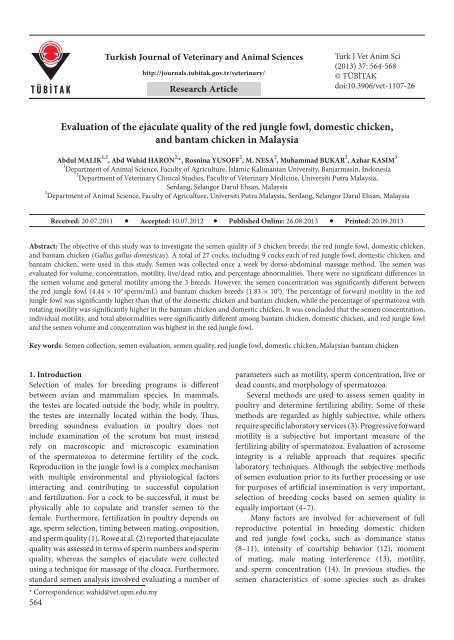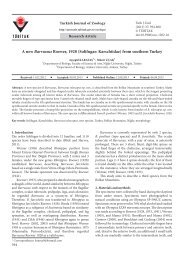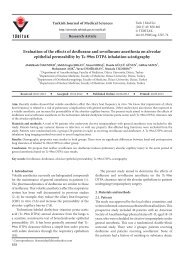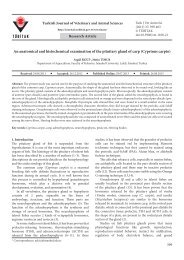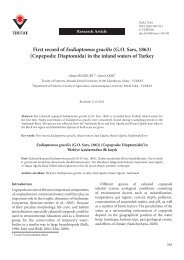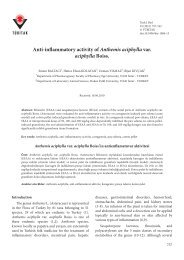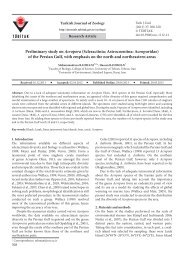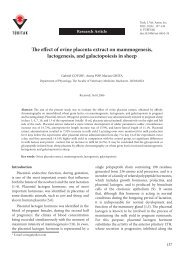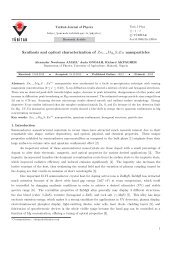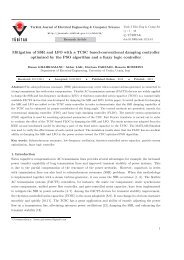Evaluation of the ejaculate quality of the red jungle fowl ... - Tübitak
Evaluation of the ejaculate quality of the red jungle fowl ... - Tübitak
Evaluation of the ejaculate quality of the red jungle fowl ... - Tübitak
Create successful ePaper yourself
Turn your PDF publications into a flip-book with our unique Google optimized e-Paper software.
Turkish Journal <strong>of</strong> Veterinary and Animal Sciences<br />
http://journals.tubitak.gov.tr/veterinary/<br />
Research Article<br />
Turk J Vet Anim Sci<br />
(2013) 37: 564-568<br />
© TÜBİTAK<br />
doi:10.3906/vet-1107-26<br />
<strong>Evaluation</strong> <strong>of</strong> <strong>the</strong> <strong>ejaculate</strong> <strong>quality</strong> <strong>of</strong> <strong>the</strong> <strong>red</strong> <strong>jungle</strong> <strong>fowl</strong>, domestic chicken,<br />
and bantam chicken in Malaysia<br />
Abdul MALIK 1,2 , Abd Wahid HARON 2, *, Rosnina YUSOFF 2 , M. NESA 2 , Muhammad BUKAR 2 , Azhar KASIM 3<br />
1<br />
Department <strong>of</strong> Animal Science, Faculty <strong>of</strong> Agriculture, Islamic Kalimantan University, Banjarmasin, Indonesia<br />
2<br />
Department <strong>of</strong> Veterinary Clinical Studies, Faculty <strong>of</strong> Veterinary Medicine, Universiti Putra Malaysia,<br />
Serdang, Selangor Darul Ehsan, Malaysia<br />
3<br />
Department <strong>of</strong> Animal Science, Faculty <strong>of</strong> Agriculture, Universiti Putra Malaysia, Serdang, Selangor Darul Ehsan, Malaysia<br />
Received: 20.07.2011 Accepted: 10.07.2012 Published Online: 26.08.2013 Printed: 20.09.2013<br />
Abstract: The objective <strong>of</strong> this study was to investigate <strong>the</strong> semen <strong>quality</strong> <strong>of</strong> 3 chicken breeds: <strong>the</strong> <strong>red</strong> <strong>jungle</strong> <strong>fowl</strong>, domestic chicken,<br />
and bantam chicken (Gallus gallus domesticus). A total <strong>of</strong> 27 cocks, including 9 cocks each <strong>of</strong> <strong>red</strong> <strong>jungle</strong> <strong>fowl</strong>, domestic chicken, and<br />
bantam chicken, were used in this study. Semen was collected once a week by dorso-abdominal massage method. The semen was<br />
evaluated for volume, concentration, motility, live/dead ratio, and percentage abnormalities. There were no significant differences in<br />
<strong>the</strong> semen volume and general motility among <strong>the</strong> 3 breeds. However, <strong>the</strong> semen concentration was significantly different between<br />
<strong>the</strong> <strong>red</strong> <strong>jungle</strong> <strong>fowl</strong> (4.44 × 10 9 sperm/mL) and bantam chicken breeds (1.83 × 10 9 ). The percentage <strong>of</strong> forward motility in <strong>the</strong> <strong>red</strong><br />
<strong>jungle</strong> <strong>fowl</strong> was significantly higher than that <strong>of</strong> <strong>the</strong> domestic chicken and bantam chicken, while <strong>the</strong> percentage <strong>of</strong> spermatozoa with<br />
rotating motility was significantly higher in <strong>the</strong> bantam chicken and domestic chicken. It was concluded that <strong>the</strong> semen concentration,<br />
individual motility, and total abnormalities were significantly different among bantam chicken, domestic chicken, and <strong>red</strong> <strong>jungle</strong> <strong>fowl</strong><br />
and <strong>the</strong> semen volume and concentration was highest in <strong>the</strong> <strong>red</strong> <strong>jungle</strong> <strong>fowl</strong>.<br />
Key words: Semen collection, semen evaluation, semen <strong>quality</strong>, <strong>red</strong> <strong>jungle</strong> <strong>fowl</strong>, domestic chicken, Malaysian bantam chicken<br />
1. Introduction<br />
Selection <strong>of</strong> males for breeding programs is different<br />
between avian and mammalian species. In mammals,<br />
<strong>the</strong> testes are located outside <strong>the</strong> body, while in poultry,<br />
<strong>the</strong> testes are internally located within <strong>the</strong> body. Thus,<br />
breeding soundness evaluation in poultry does not<br />
include examination <strong>of</strong> <strong>the</strong> scrotum but must instead<br />
rely on macroscopic and microscopic examination<br />
<strong>of</strong> <strong>the</strong> spermatozoa to determine fertility <strong>of</strong> <strong>the</strong> cock.<br />
Reproduction in <strong>the</strong> <strong>jungle</strong> <strong>fowl</strong> is a complex mechanism<br />
with multiple environmental and physiological factors<br />
interacting and contributing to successful copulation<br />
and fertilization. For a cock to be successful, it must be<br />
physically able to copulate and transfer semen to <strong>the</strong><br />
female. Fur<strong>the</strong>rmore, fertilization in poultry depends on<br />
age, sperm selection, timing between mating, oviposition,<br />
and sperm <strong>quality</strong> (1). Rowe at al. (2) reported that <strong>ejaculate</strong><br />
<strong>quality</strong> was assessed in terms <strong>of</strong> sperm numbers and sperm<br />
<strong>quality</strong>, whereas <strong>the</strong> samples <strong>of</strong> <strong>ejaculate</strong> were collected<br />
using a technique for massage <strong>of</strong> <strong>the</strong> cloaca. Fur<strong>the</strong>rmore,<br />
standard semen analysis involved evaluating a number <strong>of</strong><br />
* Correspondence: wahid@vet.upm.edu.my<br />
564<br />
parameters such as motility, sperm concentration, live or<br />
dead counts, and morphology <strong>of</strong> spermatozoa.<br />
Several methods are used to assess semen <strong>quality</strong> in<br />
poultry and determine fertilizing ability. Some <strong>of</strong> <strong>the</strong>se<br />
methods are regarded as highly subjective, while o<strong>the</strong>rs<br />
require specific laboratory services (3). Progressive forward<br />
motility is a subjective but important measure <strong>of</strong> <strong>the</strong><br />
fertilizing ability <strong>of</strong> spermatozoa. <strong>Evaluation</strong> <strong>of</strong> acrosome<br />
integrity is a reliable approach that requires specific<br />
laboratory techniques. Although <strong>the</strong> subjective methods<br />
<strong>of</strong> semen evaluation prior to its fur<strong>the</strong>r processing or use<br />
for purposes <strong>of</strong> artificial insemination is very important,<br />
selection <strong>of</strong> breeding cocks based on semen <strong>quality</strong> is<br />
equally important (4–7).<br />
Many factors are involved for achievement <strong>of</strong> full<br />
reproductive potential in breeding domestic chicken<br />
and <strong>red</strong> <strong>jungle</strong> <strong>fowl</strong> cocks, such as dominance status<br />
(8–11), intensity <strong>of</strong> courtship behavior (12), moment<br />
<strong>of</strong> mating, male mating interference (13), motility,<br />
and sperm concentration (14). In previous studies, <strong>the</strong><br />
semen characteristics <strong>of</strong> some species such as drakes
MALIK et al. / Turk J Vet Anim Sci<br />
(15), cocks (16,17), ganders (18), turkeys (19,20), and<br />
pheasants (21) were reported. Therefore, <strong>the</strong> present study<br />
was conducted to compare <strong>the</strong> <strong>ejaculate</strong> <strong>quality</strong>, including<br />
volume, concentration, percentage <strong>of</strong> motility, and types<br />
<strong>of</strong> abnormalities, in <strong>red</strong> <strong>jungle</strong> <strong>fowl</strong>, domestic chicken, and<br />
bantam chicken in Malaysia.<br />
2. Materials and methods<br />
2.1. Animal and semen collection<br />
The experiment was carried out in <strong>the</strong> Theriogenology and<br />
Cytogenetic Laboratory <strong>of</strong> <strong>the</strong> Faculty <strong>of</strong> Veterinary Medicine,<br />
Department <strong>of</strong> Animal Science, Faculty <strong>of</strong> Agriculture,<br />
Universiti Putra Malaysia (UPM). A total <strong>of</strong> 27 healthy cocks<br />
included 9 cocks each <strong>of</strong> <strong>red</strong> <strong>jungle</strong> <strong>fowl</strong>, domestic chicken,<br />
and Malaysian bantam chicken with average weights <strong>of</strong> 410<br />
± 2.34, 1.225 ± 4.41, and 1.670 ± 6.01 g, respectively. Cocks<br />
aged around 36 weeks old were used in this study. The cocks<br />
were obtained from <strong>the</strong> Department <strong>of</strong> Animal Science at<br />
<strong>the</strong> UPM Poultry Farm (2°6′N, 103°24′34″E). The mean<br />
ambient temperature and relative humidity during <strong>the</strong> study<br />
period were 30 °C and 65%, respectively. One month prior to<br />
commencement <strong>of</strong> semen collection, all cocks were kept in<br />
individual cages (32 × 34 × 53 cm). All cocks were fed with<br />
commercial poultry pellets consisting <strong>of</strong> 18% crude protein<br />
and water was provided ad libitum.<br />
Semen samples were collected once a week (Mondays)<br />
and were continued for 16 weeks. Semen collection was done<br />
once a week because <strong>the</strong> time range requi<strong>red</strong> for semen to<br />
pass from <strong>the</strong> testes to <strong>the</strong> distal region <strong>of</strong> <strong>the</strong> ductus deferens<br />
varies from 1 to 4 days (22). The time <strong>of</strong> semen collection was<br />
between 0800 and 0900 hours, and <strong>the</strong> method <strong>of</strong> collection<br />
was <strong>the</strong> abdominal manual massage method described<br />
previously (23,24). First, <strong>the</strong> cloacal area was cleaned.<br />
The back and tail fea<strong>the</strong>rs and <strong>the</strong> abdominal region were<br />
<strong>the</strong>n stroked gently and repeatedly, which resulted in <strong>the</strong><br />
tumescence (erection) <strong>of</strong> <strong>the</strong> phallus. Semen was <strong>ejaculate</strong>d<br />
after slight pressure was applied to <strong>the</strong> inverted cloaca. The<br />
semen was carefully collected in a test tube and placed in a<br />
water bath maintained at 37 °C prior to evaluation.<br />
2.2. Semen evaluation<br />
Sodium citrate and egg yolk were prepa<strong>red</strong> and used as an<br />
extender in this study. The volume <strong>of</strong> <strong>the</strong> <strong>ejaculate</strong>d semen<br />
from each cock was measu<strong>red</strong> using a graduated test tube.<br />
The pH was determined using a pH meter. Spermatozoa<br />
concentration was determined using <strong>the</strong> hemocytometer<br />
method, and <strong>the</strong> technique involved mixing semen with<br />
appropriate diluents at a dilution ratio <strong>of</strong> 1:200 with an<br />
eosin solution (1). The evaluation <strong>of</strong> sperm motility from<br />
<strong>the</strong> diluted semen was conducted at 400× magnification<br />
on a warm stage. A drop <strong>of</strong> <strong>the</strong> diluted semen was placed<br />
on a preheated slide and a cover slip was used to cover <strong>the</strong><br />
slide; <strong>the</strong> cover slip helped to prevent overflow, allowed a<br />
uniform film to form, and prevented quick drying <strong>of</strong> <strong>the</strong><br />
semen (14). The remnant <strong>of</strong> <strong>the</strong> semen in each replicate<br />
was measu<strong>red</strong> to evaluate <strong>the</strong> percentage <strong>of</strong> live and<br />
dead spermatozoa as determined from 10 µL semen,<br />
mixed with 50 µL <strong>of</strong> eosin nigrosin stain to make a thin<br />
smear. The smear was air-dried for 10 min. At least 200<br />
spermatozoa were examined (400×) under emulsion oil<br />
and those with differential morphology were counted.<br />
The color and consistency <strong>of</strong> <strong>the</strong> semen were evaluated<br />
visually, including varieties that were creamy, grainy,<br />
bloody, watery, or contaminated.<br />
2.3 Statistical analysis<br />
Data were analyzed using SPSS 16. Repeated measures<br />
analysis <strong>of</strong> variance (ANOVA) <strong>of</strong> <strong>the</strong> general linear model<br />
in SPSS was used for <strong>the</strong> analysis. Analyses were conside<strong>red</strong><br />
to be significant at P < 0.05.<br />
3. Results<br />
The average pH <strong>of</strong> <strong>the</strong> cocks’ semen in this study was<br />
7.0–7.4. The semen <strong>of</strong> <strong>the</strong> bantam chicken was watery.<br />
The volumes <strong>of</strong> semen and concentrations were 0.33 ±<br />
0.16, 0.29 ± 0.18, and 0.10 ± 0.10 <strong>ejaculate</strong>/mL and 4.44 ×<br />
10 9 ± 9.05, 2.73 × 10 9 ±10.5, and 1.83 × 10 9 ± 7.43 sperm/<br />
mL for <strong>red</strong> <strong>jungle</strong> <strong>fowl</strong>, domestic chicken, and bantam<br />
chicken, respectively (Table 1). The semen volume was<br />
not significantly different (P > 0.05) between <strong>the</strong> <strong>red</strong><br />
<strong>jungle</strong> <strong>fowl</strong> and <strong>the</strong> o<strong>the</strong>r breeds, whereas <strong>the</strong> semen<br />
Table 1. Means <strong>of</strong> volume, concentration, percentage <strong>of</strong> motility, live spermatozoa, and total abnormality <strong>of</strong> semen <strong>red</strong> <strong>jungle</strong> <strong>fowl</strong>,<br />
domestic chicken, and bantam chicken.<br />
Breeds <strong>of</strong> cocks<br />
Item<br />
Red <strong>jungle</strong> <strong>fowl</strong> Domestic chicken Bantam chicken<br />
Volume (<strong>ejaculate</strong>/mL) 0.33 ± 0.16 0.29 ± 0.18 0.10 ± 0.10<br />
Concentration (sperm/mL) 4.44 × 10 9 ± 9.05 a 2.73 × 10 9 ± 10.5 ab 1.83 × 10 9 ± 7.43 b<br />
General motility (%) 55.2 ± 6.67 57.1 ± 4.56 49.0 ± 6.03<br />
Live spermatozoa (%) 96.4 ± 0.86 97.5 ± 1.28 96.0 ± 2.27<br />
Total abnormality (%) 31.4 ± 3.70 30.3 ± 6.91 38.0 ± 4.12<br />
Values within each column with different superscripts differ significantly at P < 0.05 (n = 16).<br />
565
MALIK et al. / Turk J Vet Anim Sci<br />
concentrations were significantly higher (P < 0.05) between<br />
<strong>the</strong> <strong>red</strong> <strong>jungle</strong> <strong>fowl</strong> and bantam chicken.<br />
The percentages <strong>of</strong> spermatozoa motility, live<br />
spermatozoa, and total abnormality <strong>of</strong> <strong>the</strong> semen were 55.2<br />
± 6.67%, 57.1 ± 6.67%, and 49.0 ± 6.03%; 96.4 ± 0.86%, 97.5<br />
± 1.28%, and 96.0 ± 2.27%; and 31.4 ± 3.70%, 30.3 ± 6.91%,<br />
and 38.0 ± 4.12% for <strong>red</strong> <strong>jungle</strong> <strong>fowl</strong>, domestic chicken, and<br />
bantam chicken, respectively. Fur<strong>the</strong>rmore, <strong>the</strong> percentage<br />
distribution <strong>of</strong> individual motility (forward, rotating,<br />
vibrating, and backward) are shown in <strong>the</strong> Figure. Red<br />
<strong>jungle</strong> <strong>fowl</strong> had significantly higher (P < 0.05) sperm motility<br />
compa<strong>red</strong> to <strong>the</strong> domestic chicken and bantam chicken. All<br />
<strong>the</strong> breeds had a total live spermatozoa <strong>of</strong> more than 90%. The<br />
mean live spermatozoa among <strong>the</strong> <strong>red</strong> <strong>jungle</strong> <strong>fowl</strong>, domestic<br />
chicken, and Malaysian bantam chicken were not significantly<br />
different (Table 1).<br />
In <strong>the</strong> present study, <strong>the</strong> percentage spermatozoa<br />
abnormalities, including mid-piece knotting, bent head,<br />
plasmid droplets, spermatids, and bent tail were low<br />
(
MALIK et al. / Turk J Vet Anim Sci<br />
(27). The watery semen color <strong>of</strong> bantam chicken might<br />
be due to a low number <strong>of</strong> spermatozoa per milliliter <strong>of</strong><br />
semen. Similarly, <strong>the</strong> average semen concentration in <strong>the</strong><br />
<strong>red</strong> <strong>jungle</strong> <strong>fowl</strong> and domestic chicken were within <strong>the</strong><br />
range reported in leghorn roosters (1.7–3.5 billion/mL)<br />
in a previous study (16), but lower than that in broiler<br />
breeders (6.2 × 10 9 sperm/mL) reported by McDaniel (6).<br />
Semen concentration in <strong>the</strong> <strong>red</strong> <strong>jungle</strong> <strong>fowl</strong> was 4 times<br />
higher than in <strong>the</strong> bantam chicken. The differences in<br />
semen concentration between chickens is suspected to<br />
involve many factors such as intake <strong>of</strong> feed, and <strong>the</strong> body<br />
size could be attributed to <strong>the</strong>ir different genetic makeup<br />
and body weight.<br />
The assessment <strong>of</strong> sperm motility is one <strong>of</strong> <strong>the</strong> most<br />
<strong>of</strong>ten used parameters for semen evaluation (28–30). The<br />
values obtained for semen motility for all 3 breeds were<br />
within <strong>the</strong> range reported for normal cock semen <strong>of</strong> 40%–<br />
80% (16,25,31). Howarth (32) suggested that spermatozoa<br />
collected from cock testes, despite very poor motility, were<br />
able to fertilize <strong>the</strong> ovum, because <strong>the</strong> oviduct itself ensures<br />
<strong>the</strong>ir movement towards infundibulum. All 3 breeds <strong>of</strong><br />
chicken had a live spermatozoa percentage <strong>of</strong> more than<br />
90% and this is comparable with a previous study reported<br />
for broiler breeders (33–35).<br />
Sperm morphology was recommended to be one <strong>of</strong><br />
<strong>the</strong> most essential qualitative characteristics <strong>of</strong> poultry<br />
semen (36). It could be used as an essential parameter<br />
for p<strong>red</strong>icting <strong>the</strong> fertilizing ability <strong>of</strong> spermatozoa (37).<br />
The analyzed sperm abnormalities in this study were<br />
macrocephaly, mid-piece knotting, cytoplasmic droplets,<br />
spermatids, bent head, and bent tail. The percentage <strong>of</strong><br />
abnormalities that were part macrocephalic was more<br />
elevated than o<strong>the</strong>rs, but <strong>the</strong> total abnormality rate had<br />
similar results to adult cocks <strong>of</strong> different backgrounds<br />
(22.0%–48.0%) in previous studies (25). In conclusion, <strong>the</strong><br />
<strong>red</strong> <strong>jungle</strong> <strong>fowl</strong> has a better concentration <strong>of</strong> spermatozoa<br />
than o<strong>the</strong>r breeds.<br />
Acknowledgments<br />
The authors are grateful to Mr Yap Keng Chee, Mr Mohd<br />
Fahmi, Mr Murthi, and <strong>the</strong> staff <strong>of</strong> <strong>the</strong> Department <strong>of</strong><br />
Animal Science, UPM.<br />
References<br />
1. Brillard, J.P., McDaniel, G.R.: The reliability and efficiency <strong>of</strong><br />
various methods for estimating spermatozoa concentration.<br />
Poult. Sci., 1985; 64: 155–158.<br />
2. Rowe, M., Swaddle, J.P., Pruett-Jones, S., Webster, M.S.: Plumage<br />
coloration, <strong>ejaculate</strong> <strong>quality</strong> and reproductive phenotype in <strong>the</strong><br />
<strong>red</strong>-backed fairy-wren. J. Anim. Behav., 2010; 79: 1239–1246.<br />
3. Hazary, R.C., Wishart, G.J.: Assay <strong>of</strong> sperm <strong>quality</strong> in <strong>the</strong><br />
domestic <strong>fowl</strong> by MTT <strong>red</strong>uction. Br. Poult. Sci., 2001; 42: 111–<br />
114.<br />
4. McIntyre, D.R.: Selling sires by <strong>the</strong> dose. In: Bakst, M.R., Wishart,<br />
G.J., Eds. Proceedings <strong>of</strong> First International Symposium on <strong>the</strong><br />
Artificial Insemination <strong>of</strong> Poultry. Poultry Science Association,<br />
Savoy, IL, USA. 1995; 123–127.<br />
5. Bahr, J.M., Bakst, M.R.: Poultry. In: Hafez, E.S.E., Hafez, B., Eds.<br />
Reproduction in Farm Animals. Lea & Fibiger, Philadelphia.<br />
1987: 379–497.<br />
6. McDaniel, G.R.: Managing broiler breeders for maximum<br />
fertility. World Poult., 1995; 9: 25–27.<br />
7. Mellor, S.: Selecting males by sperm <strong>quality</strong>. World. Poult.,<br />
2001; 17: 32–34.<br />
8. Jones, M.E., Mench, J.A.: Behavioral correlates <strong>of</strong> male<br />
mating success in a multisire flock as determined by DNA<br />
fingerprinting. Poult. Sci., 1991; 70: 1493–1498.<br />
9. Cheng, K.M., Burns, J.T.: Dominance relationship and mating<br />
behavior <strong>of</strong> domestic cocks: a model to study mate-guarding<br />
and sperm competition in birds. Condor, 1988; 90: 697–704.<br />
10. Guhl, A.M., Warren, D.C.: Number <strong>of</strong> <strong>of</strong>fspring si<strong>red</strong> by<br />
cockerels related to social dominance in chickens. Poult. Sci.,<br />
1946; 25: 460–472.<br />
11. Johnsen, T.S., Zuk, M., Fessler, E.A.: Social dominance, male<br />
behaviour and mating in mixed-sex flocks <strong>of</strong> <strong>red</strong> <strong>jungle</strong> <strong>fowl</strong>.<br />
Behaviour, 2001; 138: 1–18.<br />
12. Leonard, M.L., Zanette, L.: Female mate choice and male<br />
behaviour in domestic <strong>fowl</strong>. Anim. Behav., 1998; 56: 1099–<br />
1105.<br />
13. Kratzer, D.D., Craig, J.V.: Mating behavior <strong>of</strong> cockerels: effects<br />
<strong>of</strong> social status, group size and group density. Appl. Anim.<br />
Ethol., 1980; 6: 49–62.<br />
14. Birkhead, T.R., Martinez, J.G., Burke, T., Froman, D.P.: Sperm<br />
mobility determines <strong>the</strong> outcome <strong>of</strong> sperm competition in <strong>the</strong><br />
domestic <strong>fowl</strong>. Proc. Biol. Sci., 1999; 266: 1759–1764.<br />
15. Setioko, A.R., Hetzel, D.J.S.: The effect <strong>of</strong> collection method<br />
and housing system on semen production and fertility <strong>of</strong><br />
Alabio drakes. Br. Poult. Sci.,1984; 25: 167–172.<br />
16. Lake, P.E.: A cytochemical examination <strong>of</strong> spermatozoa <strong>of</strong> <strong>the</strong><br />
domestic <strong>fowl</strong>. Res. Vet. Sci., 1966; 7: 121–127.<br />
17. Saeid, J.M., Al-Soudi, K.A.: Seasonal variation in semen<br />
characteristics <strong>of</strong> White Leghorn, New Hampshire and<br />
indigenous chicken in Iraq. Br. Poult. Sci., 1975; 16: 97–102.<br />
18. Pawluczuk, A., Grunder, A.A.: Research note: Comparison <strong>of</strong><br />
three methods <strong>of</strong> collecting semen from ganders. Poult. Sci.,<br />
1989; 68: 1714–1717.<br />
19. Burrows, W.H., Quinn, J.P.: The collection <strong>of</strong> spermatozoa<br />
from <strong>the</strong> domestic <strong>fowl</strong> and turkey. Poult. Sci., 1937; 16: 9–24.<br />
20. Noirault, J., Brillard, J.P.: Effects <strong>of</strong> frequency <strong>of</strong> semen<br />
collection on quantitative and qualitative characteristics <strong>of</strong><br />
semen on turkey breeder males. Poult. Sci., 1999; 78: 1034–<br />
1039.<br />
567
MALIK et al. / Turk J Vet Anim Sci<br />
21. Mantovani, C., Cerolini, S., Bellagamba, F., Mangiagalli, M.G.,<br />
Cavalchini, L.G.: <strong>Evaluation</strong> <strong>of</strong> pheasant semen production<br />
during <strong>the</strong> reproductive season. Reprod. Nutr. Dev., 1993; 33:<br />
503–509.<br />
22. Munro, S.S.: Functional changes in <strong>fowl</strong> sperm during <strong>the</strong>ir<br />
passage through <strong>the</strong> excurrent ducts <strong>of</strong> <strong>the</strong> male. J. Exp. Zool.,<br />
1938; 79: 71–92.<br />
23. Tuttle, E.M., Pruett-Jones, S., Webster, M.S.: Cloacal<br />
protuberances and extreme sperm production in Australian<br />
fairy-wrens. Proc. Biol. Sci., 1996; 263: 1359–1364.<br />
24. Gee, G.F., Bertschinger, H., Donoghue, A.M., Blanco, J., Soley,<br />
J.: Reproduction in nondomestic birds: physiology, semen<br />
collection, artificial insemination and cryopreservation. Avian<br />
Poult. Biol. Rev., 2004; 15: 47–101.<br />
25. Omeje, S.S.I., Marire, B.N.: <strong>Evaluation</strong> <strong>of</strong> <strong>the</strong> semen<br />
characteristics <strong>of</strong> adult cocks <strong>of</strong> different genetic backgrounds.<br />
Theriogenology, 1990; 3: 1111–1118.<br />
26. Sturkie, P.D.: Avian Physiology. 3rd edn., Springer-Verlag, New<br />
York. 1976; 334–339.<br />
27. Lake, P.E.: Male genital organs. Form and Function in Birds,<br />
1981; 2: 2–61.<br />
28. Froman, D.P., Feltmann, A.J.: Sperm mobility: a quantitative<br />
trait <strong>of</strong> <strong>the</strong> domestic <strong>fowl</strong> (Gallus domesticus). Biol. Reprod.,<br />
1998; 58: 376–384.<br />
29. Holsberger, D.R., Donoghue, A.M., Froman, D.P., Ottinger,<br />
M.A.: Assessment <strong>of</strong> <strong>ejaculate</strong> <strong>quality</strong> and sperm characteristics<br />
in turkeys: sperm mobility phenotype is independent <strong>of</strong> time.<br />
Poult. Sci., 1998; 77: 1711–1717.<br />
30. King, L.M., Kirby, J.D., Froman, D.P., Sonstegard, T.S., Harry,<br />
D.E., Darden, J.R., Marini, P.J., Walker, R.M., Rhoads, M.L.,<br />
Donoghue, A.M.: Efficacy <strong>of</strong> sperm mobility assessment in<br />
commercial flocks and <strong>the</strong> relationship <strong>of</strong> sperm mobility and<br />
insemination dose with fertility in turkeys. Poult. Sci., 2000; 79:<br />
1797–1802.<br />
31. Egbunike, C.N., Oluyemi, J.A.: Comparative studies <strong>of</strong> <strong>the</strong><br />
reproductive capacity <strong>of</strong> <strong>the</strong> Nigerian and exotic poultry<br />
breeds. Nig J. Anim. Prod., 1979; 6: 47–51.<br />
32. Howarth, B.J.: Fertilizing ability <strong>of</strong> cock spermatozoa from <strong>the</strong><br />
testis, epididymis, and vas deferens following intramagmal<br />
insemination. Biol. Reprod., 1983; 28: 586–590.<br />
33. Van Voorst, A., Leenstra, K.R.: Fertility rate <strong>of</strong> daily collected<br />
and cryopreserved <strong>fowl</strong> semen. Poult Sci., 1995; 74: 136–140.<br />
34. Bakst, M.R,. Cecil, H.C.: Technique for semen evaluation:<br />
semen storage, and fertility determination. Poult. Sci. Assoc.,<br />
1997; 419–426.<br />
35. Tselutin, K.L., Narubina, Mavrodina, T., Tur, B.:<br />
Cryopreservation <strong>of</strong> poultry semen. Br. Poult. Sci., 1995; 36:<br />
805–811.<br />
36. Kuster, C.E., Singer, R.S., Althouse, G.C.: Determining<br />
sample size for <strong>the</strong> morphological assessment <strong>of</strong> sperm.<br />
Theriogenology, 2004; 61: 691–703.<br />
37. Lukaszewicz, E.: Study <strong>of</strong> diluents <strong>of</strong> cock’s semen storage in<br />
<strong>the</strong> light <strong>of</strong> laboratory estimation and fertility rate. Poult. Sci.,<br />
1988: 43–59.<br />
568


